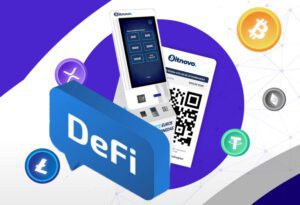
Table of Contents
ToggleDecentralized finance, or DeFi, was born as a new version of traditional finance, endowed with all the features facilitated by the blockchain. As a natural consequence, borrowing in cryptocurrencies has become an everyday occurrence.
In this blog, we have talked a lot about the benefits of decentralization and the lack of intermediaries. But, not everything is rosy in this free and deregulated economy.
Every day we come up against pitfalls, which traditional finance overcomes thanks to centralized bodies set up for the purpose, in exchange for a slice of our returns.
Today, we will see how the great minds behind the crypto-world overcame anonymity and lack of credit history to establish a new lending system.
How does a cryptocurrency loan work?
The title of the article leaves little to the imagination. Cryptocurrency loans are obviously aimed at acquiring cryptos. So, when we apply for a loan of this type, instead of “FIAT” coins, created by the Central Bank of the country in question, we will receive cryptocurrencies.
There are 2 types of loans in the crypto world. On the one hand, flying the flags of decentralization, we have those that are delivered by decentralized platforms and managed by smart contracts.
On the other hand, there are cryptocurrency loans that are managed by centralized entities, such as exchanges included in this qualification.
It is not superfluous to clarify, beyond the obvious, that this article is focused on the decentralized world. Therefore, I will talk about those crypto loans in which there is no centralized intermediary involved in their management and the interaction takes place, as we like to say in these parts, “on-chain”.
But, before continuing with our progress, let’s review certain concepts of the traditional credit system, from where the original ideas of the DeFi world took their inspiration to be later adapted to the principles of the technology that summons us.
Differences between crypto loans and traditional loans
DeFi, was born with small replicas of the world of traditional finance, implemented on the ethereum blockchain in the form of deposit and lending platforms. If we go back in time, the birth was similar to the birth of banking at the hand of the Medici.
But, one of the differences that exist between the traditional world and crypto, hits us in the eye after barely casting an eye over both systems. In the traditional world, we can know who we are dealing with, while in crypto we interact with addresses on the blockchain.
Of course, the traditional world deals with problems of this kind, there are also the scams, phishing and other avatars that the financial world must overcome. However, the possibility of having a complete data profile gives this world certain security.
Types of traditional loans
Now, when the amount of a loan is extremely high, the Bank or the borrowing institution, whichever it may be, will request a kind of guarantee, which is usually granted in the form of a physical registrable asset.
However, this is not the only requirement. Beyond the need or not for collateral, the determination to grant a loan, of varying amounts, is made on the basis of the credit history of the applicant.
So, by this we mean that, for example, if the applicant:
- Has not complied with its previous debts
- Has a history of tax problems
- There are commercial lawsuits against you
- Bankruptcy or insolvency proceedings
Most likely, the amount to be granted will be minimal or non-existent. In this way, traditional institutions look for solvent applicants who present themselves as candidates with high feasibility of possessing sufficient means to pay off their loans plus the corresponding interest.
In the crypto ecosystem, on the other hand, all these prerequisites will not be necessary to apply for a loan. Let us now look at the solution devised by the creators of the world of decentralized finance.

The prevailing crypto lending system
After this preliminary introduction, the idea of crypto-loans is already well established in the air of this article. Without the possibility of resorting to data provided by credit histories, the first DeFi platforms had to determine their own mechanisms, which ended up setting the standards within the ecosystem.
The loan in exchange for collateral
Unable to resort to the borrower’s history, the applications created on the Ethereum network, at the dawn of the DeFi world, resorted to this practical mechanism to offer the first loans to crypto users.
In this way, pioneering customers began to deposit their cryptocurrencies in exchange for a percentage return. While their coins were “locked” in a smart contract, they found the possibility of activating the “collateral” (guarantee) option.
Perhaps there, they finished understanding, if they had not done so before, where their return for depositing cryptocurrencies in these platforms comes from. Those who take out loans do so on the coins of those who deposit, and the loan rate is what makes up the deposit rate.
Collateral levels and loan health
Platforms such as Aave, gave us these concepts of “loan health”. To ensure sustainable lending platforms over time and able to withstand sharp drops in volatile currencies, a possibility always latent in our ecosystem, loans must be “over-collateralized”.
This means that if we deposit a thousand dollars in one currency, we will not be able to take a loan in a different currency for the same amount. In case the value of our collateral falls below the “healthy” limits, most platforms have developed liquidation methods.
These mechanisms do nothing more than take the collateral, sell it and thus restore the “health” or stability of the platform.
The meaning of loans, the “Money Legos”.
A very common question among those new to crypto lending is:
- “Why would I want to deposit my cryptocurrencies, which are already mine, and expose myself to the risks of a Smart Contract, to receive other cryptocurrencies in return?”
The question has its foundation and in its answer, we find the grace of this world. The concept of “Money Legos” underpins this extremely prosperous system of loans and deposits.
There are opportunities where we will find that we will be paid more for leaving a coin deposited in an application than it will cost us to borrow it on a different platform. So, here the “Money Legos” are shown in their most primitive form.
On the other hand, perhaps in mid-2020 we considered ETH to be a good investment. Because of our foresight, instead of spending it, we preferred to deposit it as collateral and take in exchange a stable currency with which to make our daily expenses. What a deal…
The management of crypto loans
This point can be seen both as an incentive or absolutely the opposite when considering the idea of applying for this type of loan.
Smart contracts, mounted on the various blockchains, are in charge of managing these loans. We know that they are programmed to react predictably, perhaps mechanically we could say, to the same stimuli and anyone with knowledge of the specific languages could check their operation without problems.
However, just as the lack of intermediaries is often attractive to crypto users, the “outside” world watches in amazement at the hacks piling up on the shelves of cybercrime.
As always, the remedy is thorough research and assumption of the risks one is willing to take.
Where to borrow cryptocurrency loans?
Far from providing investment advice or suggestions of the sort, I will go on to give some examples of prominent crypto lending platforms on the major blockchain in the DeFi world.
Ethereum
The network where the first sketches of this world saw the light of day contains some of the most experienced and secure platforms on the market.
Examples such as Aave and Compound have been with us since the early days. Maker Dao, although not specifically a “lending” platform, with its vaults in which we leave collateral to “mine” DAI, often resembles one of them.
Terra
Undoubtedly, no one comes close to Terra’s most important blockchain platform, Anchor Protocol, and its stable rate that hovers between 17 and 22%.
In any case, competitors such as Mars Protocol, known as the red bank, and Edge Protocol, deploy their goodness on the network, trying to show themselves as viable alternatives when it comes to borrowing.
Avalanche
This network, compatible with Ethereum’s virtual machine, has platforms such as Aave, Terra’s own Anchor, Benqi and Iron Bank, among the most prominent in terms of your LTV or total locked value.
Fantom
Another EVM compatible blockchain EVM that shows us at the top of its ranking, in terms of lending platforms sorted by LTV, exemplars such as:
- Scream
- Geist Finance
- Tarot
- Market
As I stated at the beginning, the intention of this section is to present some platforms to get the idea that the variety in the crypto world is huge. For conducting your own research, DeFi Lama is a great tool.

Future solutions and cutting-edge ideas
There is no doubt that the system of loans in the crypto world works for an immeasurable number of users, who have solved problems in their daily lives thanks to borrowing in cryptocurrencies.
Anyway, the collateralization of the loan, remains a barrier to entry that, still for many users, ends up being insurmountable or prohibitive.
The future plans of crypto-mentals aim to achieve a lending system without the need for prior collateralization, in order to finally achieve full inclusion.
The creation of credit histories without the need to know the person behind the address in the blockchain, credit power sessions and digital identity projects, are different approaches, with the same goal. As of today, we do not find prevailing solutions. But knowing the efforts devoted to these solutions, we are confident that they will not be long in coming.
Final reflection
Bitcoin, the first cryptocurrency in history and the one that gave birth to blockchain technology, is now 13 years old. Ethereum, the first network capable of supporting smart contracts that gave birth to the DeFi ecosystem, is only 7 years old this year.
The feeling of being at the dawn of a techno-economic revolution is replicated with each new publication of a “smart contract” on a network.
With so few years, we can find an ecosystem that matures day by day, repairing the faults it discovers along the way. The future of crypto lending, as well as that of the entire DeFi ecosystem, is still in its infancy, but great achievements are already predicted for its adolescence.








